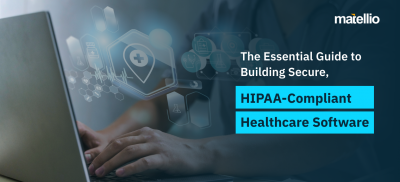
The healthcare sector has evolved immensely with the innovation in technologies in the last few years. The healthcare sector has shifted its focus on telemedicine since the pandemic and trying every way to deliver an unforgettable experience to the patients. One such product of technological innovation is EHR or Electronic Health Records. It helps physicians and doctors to stay updated with every minute detail related to their treatments and the internal process of the hospital or any healthcare organization.
Sharing data of patients is routine work inside a hospital for a better understanding of the case. With EHR, physicians share data electronically with other physicians for better care, and all they need is the patient’s name, date of birth, and possibly other personally identifiable information to access the patient’s complete medical history. Diagnosis and treatment decisions may be changed based on the information contained therein, which is much more complete than what the patient could have written on the paper. Because EHRs make information readily available, the patient’s need to repeat costly and often inconvenient tests is greatly minimized.
If you want to implement electronic health records in your organization, this might be the right time as the global market trends are in support of the process. Let’s dig in deep to find out the benefits, challenges, and process of electronic health records implementation.
What are Electronic Health Records?

An electronic medical record (EHR) is a longitudinal electronic record of a patient’s health information generated by one or more exposures in any care setting. This information includes patient demographics, progress notes, problems, medications, vital signs, previous medical history, immunizations, laboratory data, and radiological reports. EHR automates and simplifies the doctor’s workflow. The EHR is capable of compiling a complete clinical patient exposure record, as well as supporting, directly or indirectly through the interface, other care-related activities, including evidence-based decision support, quality management, and reporting of results.
Electronic health records are also widely known as electronic medical records (EMRs), and many people use the term interchangeably. The EHR can be described as an electronic version of a patient’s medical record that has been historically created, used, and stored as a paper table. The patient’s EHR is created, administered, and administered by a healthcare organization. The electronic health record can only be accessed and used by healthcare professionals involved in patient care. A personal medical record (PHR) is a medical record that is controlled by the patient and can be changed. EHRs are protected by a federal law called the Health Insurance Portability and Liability Act (HIPAA).
Benefits of Implementing Electronic Health Records
Electronic health records deliver a ton of benefits which helps in optimizing the workflow of the businesses. Despite the slowdown of the market in the year 2020 due to the pandemic, the global market of the EHR implementation came back stronger, and businesses realized the importance of the said process. The worldwide electronic health records (EHR) market size is forecasted to cross the mark of 39,913.16 million USD by the year 2026. The current growth rate of the market is 5.4%. Let’s take a look at the benefits that come with EHR implementations.
Extremely Affordable
Advances in telemedicine have already enabled people to access a wider range of care in a more affordable and convenient way. Instead of traveling long distances to see specialists or have a prescription refilled, a patient can often consult a doctor via video conference or use a mobile app to perform automatic fillings. With the development of healthcare technology, the benefits of EHR are expanding and offer opportunities to make healthcare more affordable for patients.
Patient’s Privacy
In healthcare, patient confidentiality should be the top priority. The Health Insurance Portability and Liability Act (HIPAA) is a very strict law that requires healthcare providers to protect patient confidentiality and the safety of a patient’s medical history; otherwise, severe federal penalties will result. EHRs must have comprehensive security systems in place to protect unauthorized access to a patient’s medical history. EHRs use passwords, biometrics, and network firewall security; it protects against unauthorized access to patient data.
Easily Share Data
In the current scenario of healthcare systems, almost all health records are on paper charts. This makes transferring the patient card a burdensome undertaking. If the patient moves or goes to another healthcare professional, the patient chart should be sent to a new location. This is a big undertaking because the chart needs to be copied and sent to a new location and is often incomplete. The original chart is usually the property of the hospital and must be kept by them. The EHR takes care of this problem because patient records can be sent wherever the patient is with the help of cloud technology.
The Use of Data Technology
As EHRs store a huge amount of readily available data, they are invaluable for performance improvement projects and quality assurance. Facilities can also use this data on a larger scale. For instance, any healthcare business has a set of standards for their services and data; they want their EHR developers to maintain their standards with the implementation of data technologies that have emerged in the last decade to facilitate better workflow.
Smooth Workflows
EHRs increase productivity and efficiency while reducing paperwork. With a perfect system, the staff and the patients would not have to fill a pile of forms, which saves time. Cover letters and receipts can be sent quickly, reducing waiting times for appointments and pick-ups. Automatic reminders can notify patients when it is time for an annual check-up or alert them when they approach milestones that require regular screening. With integrated patient tracking, billing and insurance claims can be submitted in a timely and effective manner.
Extreme Quality
The EHR allows hospitals and physicians to monitor the information they need to comply with insurance companies and federal regulations. The EHR acts as a central database in which doctor’s orders for laboratory, X-ray, and other examinations are stored. This information can be monitored to see if the doctor is prescribing appropriate tests for the patient’s condition. It also allows health care providers to provide high-quality data to the federal government.
Implementation of Electronic Health Records
Just like the development process of any software or an app, implementation of any technology requires a strategic approach. While implementing EHRs, there are a lot of areas you need to cover before even starting the process. Matellio has been operating in the software development industry for more than a decade; with our experience, we have developed and implemented several processes. Here are the easy steps we have designed for you to facilitate an easy EHR implementation.
Gather the Team
Electronic Health Records implementation requires a team of experts with experience in their niche. You have to decide which one of your team members has the required experience or the capability. If you are falling short of resources, you always have the option to hire them for a shorter period of time.
Read More: Enhance patient care and streamline operations with a leading EHR software development company.
Plan Your Perfect Roadmap
Now that you have gathered your team, brainstorm ideas to find a perfect roadmap for the process. It should cover all the important data of your implementation process, the project scope, scheduling, timeline, and more. Figuring things out beforehand by trusting the healthcare technology consulting services gives you an advantage in case of any error as you have already planned for the same.
Decide Your Budget
Electronic health records implementation comes with a wide bill, but it will only affect your budget if you want a wide array of things that are not even related to your process. Your budget planning should consider a number of features, development partner fees, data backup charges, training fees, consultation, maintenance, and more.
Configure Your EHR System
The next step in the process consists of configuring your EHR system. There are few systems that automatically retrieve the data of patients from the old system, but if needed, you would have to ask your development partner to get it done for you. Define various parameters of your workflow and how you want them represented in the EHRs for enhanced productivity.
Also Read- How AI based EHR Systems are Transforming Healthcare?
Streamline the Workflow
Once the EHR is implemented, initiate testing it from different users’ and physicians’ perspectives. The more you will test it, the more it will generate feasible results or errors, which will help you in knowing the system. Once you have it all straightened out, it will significantly enhance your workflow.
Educate the Team & Reduce Challenges
Whenever an organization introduces a new system, it does require a certain level of training for its staff to get the most efficiency from it. The same goes for the EHRs; you have to educate your team about every process of the system for a better efficiency rate and enhanced productivity. You can hire a trainer, or you can just ask your development partner to train your team regarding the working of the system. It will also help you in tackling all the challenges that come your way during the starting phase.
The Future of Electronic Health Records
The future of EHR technology is considered to be extremely bright, and along with the new technologies, the uses for EHR data are already crossing industry barriers. As all healthcare providers have EHR technologies installed, deployed, and shared data, opportunities to improve treatment will develop through better data collection and analysis. Health data can be mined, and this opens up new opportunities to improve health and reduce costs. Some health experts agree that the extraction of health data is used to predict potential patients who may develop chronic diseases.
Another important use of health data collected in the EHR is the federal government’s plans to collect health data and compare best treatment options to develop best practices for treating conditions and diseases. This collection of health data is called comparative efficiency, and the government believes it reduces health costs through data mining and the use of data analysis. When EHRs are widely used, interoperability will increase, and health data can be shared across the healthcare continuum. New technologies are also coming to the fore, enabling healthcare providers to improve practice workflows and offer opportunities for efficiency gains. Barcodes are a technology widely used in healthcare today, mainly in larger institutions. Further, there will be more additions into the field of EHRs, and the emerging technologies will help EHR in getting the success and wide acceptance that it deserves.
Ready to Develop Your EHR System with Matellio?
Health records have been in existence since medieval periods, as doctors or physicians needed to record their patient’s data for research or to keep track of the treatment. In current times, emerging technologies have made it possible to develop a system that automatically records the healthcare data and helps in easy sharing while maintaining extreme privacy. If you are thinking of developing an EHR system, Matellio has a perfect plan for you.
We have been developing robust, scalable, and feature-enriched healthcare digital solutions for more than a decade. Our team of qualified developers and experts has diversified experience that helps them in delivering elegant solutions based on next-gen technologies. We understand your needs better than anyone and deliver a digital solution perfectly designed as per your business needs. Our experts will be happy to guide you through the process while discussing your idea over a 30-min free consultation call! Book today!






